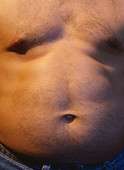(HealthDay)—The incidence of paradoxical adipose hyperplasia (PAH) following cryolipolysis may be higher than previously described, according to a report published in the August issue of Lasers in Surgery and Medicine.
Noting that the incidence of PAH has been estimated at 0.0051 percent, Selina M. Singh, M.D., from the University of Texas Health Science Center in Houston, and colleagues describe two cases of PAH from a single practice. The two men underwent cryolipolysis treatments, and had demarcated tissue growth in the treatment areas after treatment. Both men underwent corrective liposuction treatment. Adipose tissue samples were collected from the treated and non-treated areas, and were processed and stained.
The researchers found that the incidence of PAH within a single practice was 0.47 percent; two in 422 cryolipolysis treatments. An increased number of adipocytes, fibrosis, and scar tissue were seen on histopathologic examination of the subcutaneous tissue mass in the treated areas compared with control areas. On histopathologic examination of the affected tissues no lipoblasts were identified.
"By understanding the pathogenesis, this rare adverse effect may be avoided, or even utilized as a therapeutic alternative for the treatment of congenital or acquired lipodystrophy," the authors write.
More information:
Abstract
Full Text (subscription or payment may be required)
Journal information: Lasers in Surgery and Medicine
Copyright © 2015 HealthDay. All rights reserved.
























